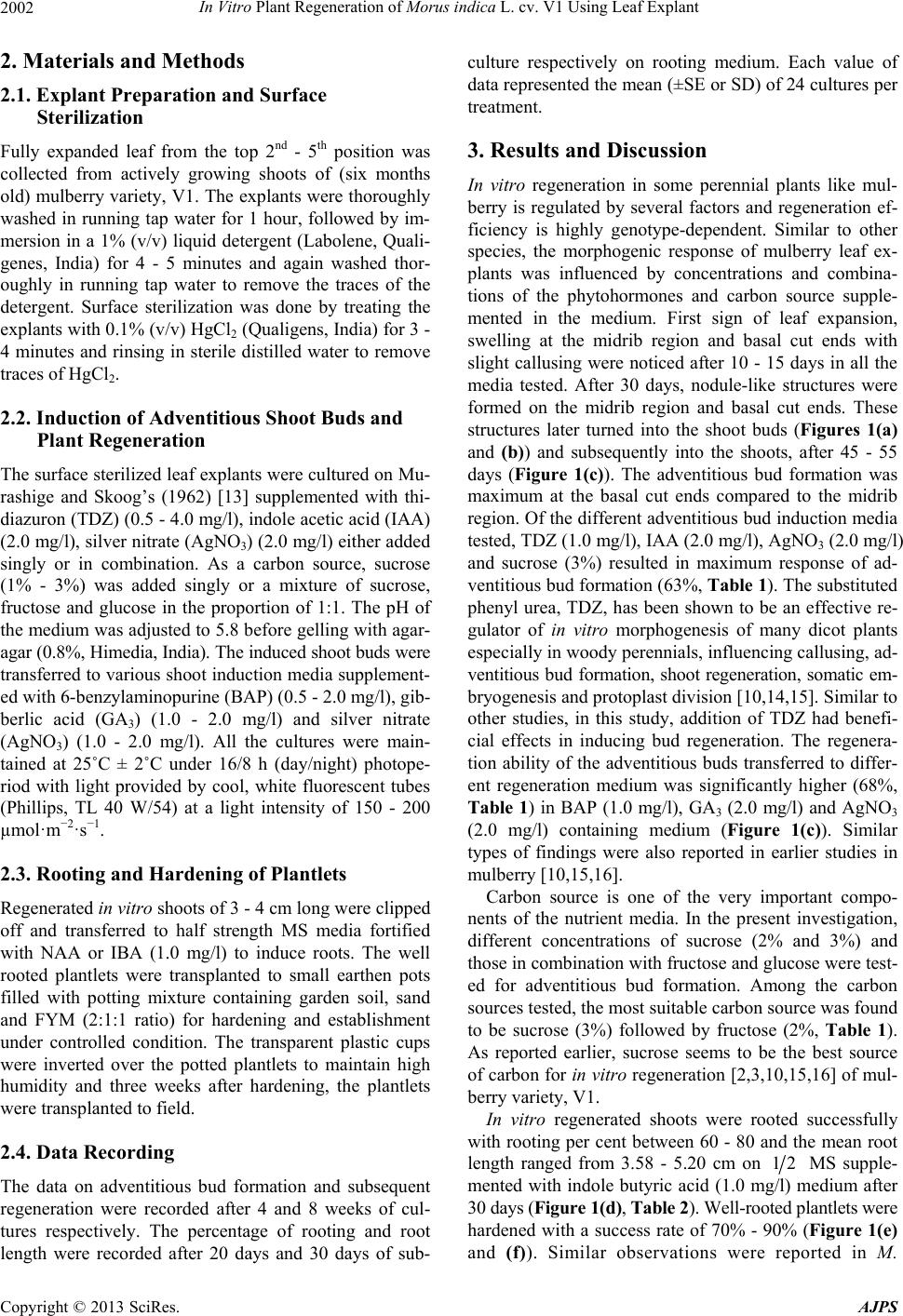
In Vitro Plant Regeneration of Morus indica L. cv. V1 Using Leaf Explant
2002
2. Materials and Methods
2.1. Explant Preparation and Surface
Sterilization
Fully expanded leaf from the top 2nd - 5th position was
collected from actively growing shoots of (six months
old) mulberry variety, V1. The explants were thoroughly
washed in running tap water for 1 hour, followed by im-
mersion in a 1% (v/v) liquid detergent (Labolene, Quali-
genes, India) for 4 - 5 minutes and again washed thor-
oughly in running tap water to remove the traces of the
detergent. Surface sterilization was done by treating the
explants with 0.1% (v/v) HgCl2 (Qualigens, India) for 3 -
4 minutes and rinsing in sterile distilled water to remove
traces of HgCl2.
2.2. Induction of Adventitious Shoot Buds and
Plant Regeneration
The surface sterilized leaf explants were cultured on Mu-
rashige and Skoog’s (1962) [13] supplemented with thi-
diazuron (TDZ) (0.5 - 4.0 mg/l), indole acetic acid (IAA)
(2.0 mg/l), silver nitrate (AgNO3) (2.0 mg/l) either added
singly or in combination. As a carbon source, sucrose
(1% - 3%) was added singly or a mixture of sucrose,
fructose and glucose in the proportion of 1:1. The pH of
the medium was adjusted to 5.8 before gelling with agar-
agar (0.8%, Himedia, India). The induced shoot buds were
transferred to various shoot induction media supplement-
ed with 6-benzylaminopurine (BAP) (0.5 - 2.0 mg/l), gib-
berlic acid (GA3) (1.0 - 2.0 mg/l) and silver nitrate
(AgNO3) (1.0 - 2.0 mg/l). All the cultures were main-
tained at 25˚C ± 2˚C under 16/8 h (day/night) photope-
riod with light provided by cool, white fluorescent tubes
(Phillips, TL 40 W/54) at a light intensity of 150 - 200
µmol·m−2·s−1.
2.3. Rooting and Hardening of Plantlets
Regenerated in vitro shoots of 3 - 4 cm long were clipped
off and transferred to half strength MS media fortified
with NAA or IBA (1.0 mg/l) to induce roots. The well
rooted plantlets were transplanted to small earthen pots
filled with potting mixture containing garden soil, sand
and FYM (2:1:1 ratio) for hardening and establishment
under controlled condition. The transparent plastic cups
were inverted over the potted plantlets to maintain high
humidity and three weeks after hardening, the plantlets
were transplanted to field.
2.4. Data Recording
The data on adventitious bud formation and subsequent
regeneration were recorded after 4 and 8 weeks of cul-
tures respectively. The percentage of rooting and root
length were recorded after 20 days and 30 days of sub-
culture respectively on rooting medium. Each value of
data represented the mean (±SE or SD) of 24 cultures per
treatment.
3. Results and Discussion
In vitro regeneration in some perennial plants like mul-
berry is regulated by several factors and regeneration ef-
ficiency is highly genotype-dependent. Similar to other
species, the morphogenic response of mulberry leaf ex-
plants was influenced by concentrations and combina-
tions of the phytohormones and carbon source supple-
mented in the medium. First sign of leaf expansion,
swelling at the midrib region and basal cut ends with
slight callusing were noticed after 10 - 15 days in all the
media tested. After 30 days, nodule-like structures were
formed on the midrib region and basal cut ends. These
structures later turned into the shoot buds (Figures 1(a)
and (b)) and subsequently into the shoots, after 45 - 55
days (Figure 1(c)). The adventitious bud formation was
maximum at the basal cut ends compared to the midrib
region. Of the different adventitious bud induction media
tested, TDZ (1.0 mg/l), IAA (2.0 mg/l), AgNO3 (2.0 mg/l)
and sucrose (3%) resulted in maximum response of ad-
ventitious bud formation (63%, Table 1). The substituted
phenyl urea, TDZ, has been shown to be an effective re-
gulator of in vitro morphogenesis of many dicot plants
especially in woody perennials, influencing callusing, ad-
ventitious bud formation, shoot regeneration, somatic em-
bryogenesis and protoplast division [10,14,15]. Similar to
other studies, in this study, addition of TDZ had benefi-
cial effects in inducing bud regeneration. The regenera-
tion ability of the adventitious buds transferred to differ-
ent regeneration medium was significantly higher (68%,
Table 1) in BAP (1.0 mg/l), GA3 (2.0 mg/l) and AgNO3
(2.0 mg/l) containing medium (Figure 1(c)). Similar
types of findings were also reported in earlier studies in
mulberry [10,15,16].
Carbon source is one of the very important compo-
nents of the nutrient media. In the present investigation,
different concentrations of sucrose (2% and 3%) and
those in combination with fructose and glucose were test-
ed for adventitious bud formation. Among the carbon
sources tested, the most suitable carbon source was found
to be sucrose (3%) followed by fructose (2%, Table 1).
As reported earlier, sucrose seems to be the best source
of carbon for in vitro regeneration [2,3,10,15,16] of mul-
berry variety, V1.
In vitro regenerated shoots were rooted successfully
with rooting per cent between 60 - 80 and the mean root
length ranged from 3.58 - 5.20 cm on 12 MS supple-
mented with indole butyric acid (1.0 mg/l) medium after
30 days (Figure 1(d), Table 2). Well-rooted plantlets were
hardened with a success rate of 70% - 90% (Figure 1(e)
and (f)). Similar observations were reported in M.
Copyright © 2013 SciRes. AJPS